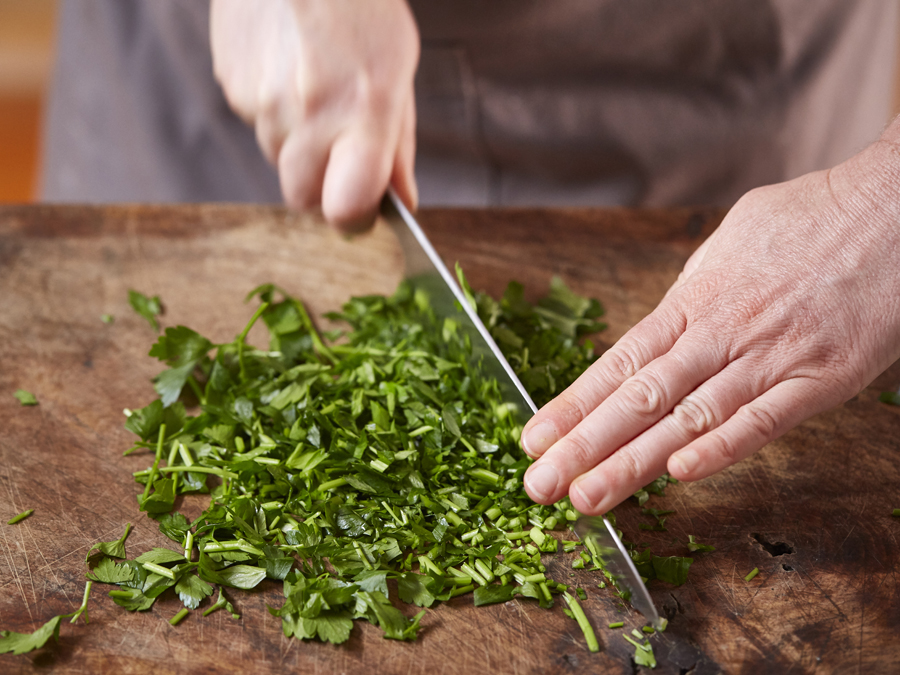How to use knives safely
How to use knives safely

Good, sharp knives are an essential part of any kitchen. So let’s learn the basics of knife safety!
General Knife Safety Tips:
1. Secure your chopping board.
A damp cloth underneath will stop your board from slipping.

2. Never wave a knife in the air.
3. Keep your knives clean.
It’s important to keep all your kitchen equipment clean, but it’s imperative with your knives. If a knife handle is oily or greasy, stop immediately and clean it. You want a secure grip at all times.

4. Create a flat surface on your ingredient before cutting it.
If the ingredient being chopped is round or uneven, like an onion, slice a bit off and create a flat, stable surface to lay on the board while cutting. Always chop flat-side down!
5. Take your time.
Never chop quickly - work slowly and steadily. Take the time to get to know the knife. Remember practice makes perfect.
6. Don’t leave your knives lying around.
When you’ve finished using your knife, clean it and put it away immediately or at least put it where others can see it. Whatever you do, don’t leave it in a sink full of soapy water where someone risks cutting themselves.
7. Sharpen your knives.
It may sound strange but a blunt knife can do more damage than a sharp one. You’re more likely to apply greater force and a dull blade risks slipping off.

8. Always hold a knife in your dominant hand.
Use your knife with your writing hand.
KNIFE HANDLING TECHNIQUES:
Okay, let’s get to the pointy end of this knife safety guide, good technique. There are three main knife handling techniques, the bridge, the claw and the cross chop.
1. The Bridge Knife Technique.
If you want to cut ingredients into smaller, more manageable pieces… take it to the bridge!
Form a bridge over the ingredient with your hand, making the sure the arch is nice and high so there’s plenty of room for the knife to fit underneath. Hold the item securely with your fingers on one side and your thumb on the other.
Now pick up the knife with the other hand and guide it under the middle of the bridge.
Cut into the middle of the ingredient by pressing down and sliding the knife back towards you out of the bridge. Then take one half at a time and place them flat-side down. Repeat the bridge over each half one at a time and cut into quarters. Keep going until you’ve got the number of pieces you need.
Never rush! It’s important to take your time and stop between each slice to check your fingers are out of the way.


2. The Claw Knife Technique.
The claw technique is used to slice ingredients into strips
Place the item onto the board, flat-side down. Make a claw by partly curling your fingers closely together, making sure you tuck your finger tips and thumb out of the way.
Pick up the knife with your other hand, check the blade is facing down and place your claw on top of the ingredient, with your fingers facing the blade. Keep the tip of the knife on the board and slowly slice through your ingredient, sliding the knife back towards you.
To make your next slice, move your fingers back along the item, keeping your fingers together and keeping a grip on the top. Remember, stop between slices to look at where your knife is and make sure your fingers are tucked out of the way.


3. The Cross Chop Knife Technique.
The cross-chop technique is used to finely chop vegetables or herbs.
To begin, cut your vegetable or herb into rough pieces, using the techniques above.
Hold the knife handle firmly in one hand, and place the tip of the knife on the board at an angle of roughly 20 degrees.
Keep the fingers of your other hand rigid on the top edge of the lower half of the blade. Keeping the tip of the knife on the board, raise and lower the handle of the knife like a guillotine, so it chops whatever is under it.

___________
For more everyday inspiration, updates on the latest trends and exclusive offers, register now as a Stockland Member to receive monthly updates, latest news, and exclusive events from your local Stockland Shopping Centre.
All reasonable care has been taken to ensure that the information is correct at the time of the content going live. However, no warranty is given as to the accuracy of that information. The information may change from time to time without notice.
Our Privacy Policy sets out how we, Stockland Corporation Limited and our related companies and trusts (“We”), collect, use, store, disclose and manage your personal information. More information can be found here.